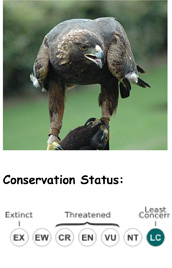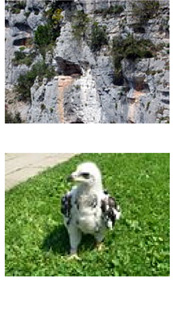
Scientific Classification:
- Kingdom: Animalia
- Phylum: Chordata
- Class: Aves
- Subclass: Neornithes
- Infraclass: Neognathae
- Superorder: Neoaves
- Order: Falconiformes
- Family: Accipitridae
- Genus: Aquila
- Species: A. chrysaetos


References: *BirdLife International (2004). Haliaeetus leucocephalus. 2006 IUCN Red List of Threatened Species. IUCN 2006. Retrieved on 2007-11-11. *del Hoyo, J., Elliott, A., & Sargatal, J., eds. (1994). Handbook of the Birds of the World Vol. 2. Lynx Edicions, Barcelona *”Bald Eagle Facts and Information”. Eagles.org. Retrieved on 2008-11-03. *”Bald Eagle Fact Sheet”. Southern Ontario Bald Eagle Monitoring Project. Retrieved on 2008-06-30. *Harris. “Bald Eagle Haliaeetus leucocephalus”. University of Michigan Museum of Geology. Retrieved on 2007-06-21. *”Bald Eagle, Haliaeetus leucocephalus”. Cornell Lab of Ornithology. Retrieved on 2007-06-21. *Sibley, D. (2000). The Sibley Guide to Birds. National Audubon Society *Bird, D.M. (2004). The Bird Almanac: A Guide to Essential Facts and Figures of the World’s Birds. Ontario: Firefly Books. *Joshua Dietz. “What’s in a Name”. Smithsonian National Zoological Park. Retrieved on August 19, 2007. *Liddell, Henry George and Robert Scott (1980). A Greek-English Lexicon (Abridged Edition). UK: Oxford University Press. *Linnaeus, Carolus (1766). Systema naturae per regna tria naturae, secundum classes, ordines, genera, species, cum characteribus, differentiis, synonymis, locis. Tomus I. Editio duodecima, reformata.. Holmiae. (Laurentii Salvii).. *”Haliaeetus leucocephalus” (in English). Integrated Taxonomic Information System. Retrieved on 2007-06-21. *”Bald Eagle Haliaeetus leucocephalus”. The Pacific Wildlife Foundation. Retrieved on 2007-06-27. *Brown, N. L.. “Bald Eagle Haliaeetus leucocephalus”. Retrieved on 2007-08-20. *Wink, M; Heidrich, P. & Fentzloff, C (1996). “A mtDNA phylogeny of sea eagles (genus Haliaeetus) based on nucleotide sequences of the cytochrome b gene” (pdf). Biochemical Systematics and Ecology 24: 783–791. *”Bald Eagle Habitat” (in English). Bald-Eagles.info. Retrieved on 2007-06-21. *”WILDLIFE SPECIES: Haliaeetus leucocephalus”. USDA Forest Service. Retrieved on 2007-06-21. *Bull J, Farrand, J Jr (1987). Audubon Society Field Guide to North American Birds:Eastern Region. New York: Alfred A. Knopf. pp. 468–9. *British Ornithologists’ Union Records Committee. “25th Report (October 1998)”. British Ornithologists Union. Retrieved on 2007-08-19. *Hope Rutledge. “Where to View Bald Eagles”. Retrieved on 2007-08-20. *Terres, J. K. (1980). The Audubon Society Encyclopedia of North American Birds. New York, NY: Knopf. pp. 644–646. *Daum, David W.. “Bald Eagle”. Alaska Department of Fish & Game. Retrieved on 2007-08-15. *http://www.seaworld.org/animal-info/info-books/raptors/diet.htm *Jorde, D.G.; Lingle, G (1998). “Kleptoparasitism by Bald Eagles wintering in South-Central Nebraska” (PDF). Journal of Field Ornithology 59 (2): 183–188. *http://www.sandiegozoo.org/animalbytes/t-bald_eagle.html *R.F. Stocek. “Bald Eagle”. Canadian Wildlife Service. Retrieved on 2007-08-19. *”Bald Eagle (Haliaeetus leucocephalus)”. Michigan Department of Natural Resources. Retrieved on 2007-04-24. *Erickson, L. (2007). Bald Eagle Journey North About Bald Eagle Nests *Brown, Leslie (1976). Birds of Prey: Their biology and ecology. Hamlyn. p. 226. *”Bald Eagle Facts and Information”. American eagle foundation. Retrieved on 2008-01-03. *Milloy, Steven (2006-07-06). “Bald Eagle”, Fox News. Retrieved on 3 January 2008. *EPA press release (1972-12-31). “DDT Ban Takes Effect”, US Environmental Protection Agency. Retrieved on 22 August 2007. *Barrera, Jorge (2005-07-04). “Agent Orange has left deadly legacy Fight continues to ban pesticides and herbicides across Canada”. Retrieved on 22 August 2007. *’’Bald Eagle Soars Off Endangered Species List”. U.S. Department of the Interior (2007-06-28). Retrieved on 2007-08-27. *BirdLife International (2004). Haliaeetus leucocephalus. 2006 IUCN Red List of Threatened Species. IUCN 2006. Retrieved on 2008-01-03. *Maestrelli, John R.; Stanley N. Wiemeyer (March 1975). “Breeding Bald Eagles in Captivity”. The Wilson Bulletin 87 (I). *Fish and Wildlife Conservation Act, 1997. Ministry of Attorney General. *”Original Design of the Great Seal of the United States (1782)”. National Archives. Retrieved on 2007-08-19. *Mikkelson, Barbara & Mikkelson, David P. “A Turn of the Head”. snopes.com. Retrieved on 2007-08-19. *Julie Collier. “The Sacred Messengers”. Mashantucket Pequot Museum. Retrieved on 2007-05-20. *Melmer, David (2007-06-11). “Bald eagles may come off threatened list”, Indian Country Today. Retrieved on 23 August 2007. *Brown, Steven C.; Averill, Lloyd J.. “Sun Dogs and Eagle Down”, University of Washington Press. Retrieved on 23 August 2007. *O’Brien, Greg. “Power Derived from the Outside World”. Choctaws in a Revolutionary Age, 1750-1830. Univ of Nebraska Press. p. 58. *Lawrence, Elizabeth Atwood. “The Symbolic Role of Animals in the Plains Indian Sun Dance”, University of Washington Press. Retrieved on 23 August 2007. *DeMeo, Antonia M. (1995). “Access to Eagles and Eagle Parts: Environmental Protection v. Native American Free Exercise of Religion”. Hastings Constitutional Law Quarterly 22 (3): 771–813. http://www.animallaw.info/articles/ar22hstclq771.htm. Retrieved on 22 August 2007. *Boradiansky, Tina S.. “Conflicting Values: The Religious Killing of Federally Protected Wildlife”, University of New Mexico School of Law. Retrieved on 23 August 2007.


Learn About Golden Eagles
The Golden Eagle (Aquila chrysaetos) is one of the best known birds of prey in the Northern Hemisphere.
Most subspecies of Golden Eagle vary in the range from 65 to 100 cm, wingspan can range from 150 to 240 cm, and weight is from 2.5 to 7 kg (5.5–15.5 lb). The plumage colours range from black-brown to dark brown, with a striking golden-buff crown and nape, which give the bird its name. The upper wings also have an irregular lighter area. Immature birds resemble adults, but have a duller more mottled appearance. Also they have a white-banded tail and a white patch at the carpal joint that gradually disappear with every moult until full adult plumage is reached in the fifth year.
Golden eagle prey includes marmots, hares and mice, and sometimes birds, martens, foxes, small tortoises, young deer, and livestock including lambs and young goats. During winter months when prey is scarce, Golden Eagles scavenge on carrion to supplement their diet. Sometimes when no carrion is available golden eagles will hunt down owls, hawks, falcons, and large ungulates. Golden eagles are avian apex predators, meaning a healthy adult is not preyed on.
Golden Eagles have very good eyesight and can spot prey from a long distance. The Golden Eagle has a resolving power 8x more powerful than a human.
Golden Eagles usually mate for life. They build several eyries within their territory and use them alternately for several years. These nests consist of heavy tree branches, upholstered with grass when in use. Old eyries may be 2 metres (6.6 ft) in diameter and 1 metre (3.3 ft) in height, as the eagles repair their nests whenever necessary and enlarge them during each use. If the eyrie is situated on a tree, supporting tree branches may break because of the weight of the nest. Certain other animals – birds and mammals too small to be of interest to the huge raptor – often use the nest as shelter.
The female lays two black eggs between January and September (depending on the locality). They start incubation immediately after the first egg is laid, and after 45 days on average the young hatch. They are entirely white and are fed for fifty days before they are able to make their first flight attempts and eat on their own. In most cases only the older chick survives, while the younger one dies without leaving the eyrie. This is due to the older chick having a few days’ advantage in growth and consequently winning most squabbles for food.
At one time, the Golden Eagle lived in temperate Europe, North Asia, North America, North Africa and Japan. In most areas this bird is now a mountain-dweller. In North America the situation is not as dramatic, but there has still been a noticeable decline. The main threat is habitat destruction which by the late 19th century already had driven Golden Eagles from some regions they used to inhabit.
Available habitat and food are the main limiting factor nowadays. Collisions with power lines have become an increasingly significant cause of mortality since the early 20th century. On a global scale, the Golden Eagle is not considered threatened by the IUCN mainly thanks to the large Asian and American populations.